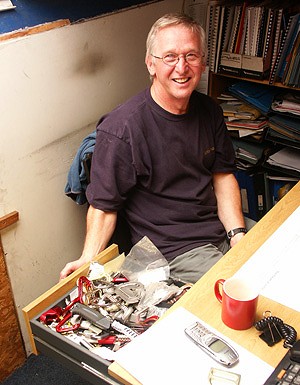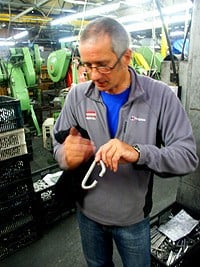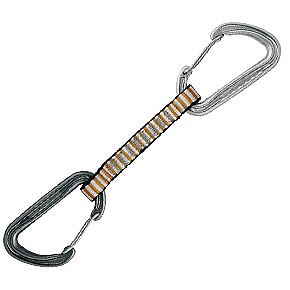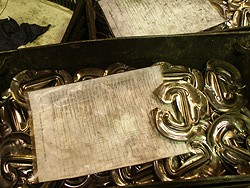
DMM (website) have been making climbing gear since 1981. They are based in Llanberis, North Wales and employ 110 people making them the most important employer in Llanberis. If you are a climber you probably have a several bits of DMM gear. They have designed and produced innovative products like the Predator, Rebel and Anarchist Ice tools Ice; the Terminator crampon; and a whole host of innovative carabiners like the Mamba, Wirelocks and Revolvers.
Most recently they have developed the strongest, lightest 'biner in the world, the Phantom. It weighs 25.5 grams without compromising strength, it achieves a 9 kn gate open rating.
The Phantom carabiner was chosen as our first Product of the week (click here) at UKClimbing.com. UKClimbing.com asked Chris Rowlands, marketing director at DMM about the Phantom carabiner.


I reckon so. It is what most people would call the lightest climbing carabiner in the world. It isn't a keyring or a toy, it is very strong, light, and a useable size.
Why is light right?
Light is generally right, but can be more important in certain situations. The Phantom will excel when you need to carry lots of draws, such as on a big Trad route, or if you are carrying lots of gear up into the mountains. In contrast, on a fairly straight forward sport route, other issues become equally if not more important such as ease of clipping, a clean nose etc.
How did gear wizard and alchemist Fred Hall work his magic with this new creation.....what's this alloy you speak off?
Fred is definitely a wizard (quite a small one, but definitely a wizard !). One of the most important contributory factors was the use of the I Beam design which Fred introduced on the Revolver and which has subsequently been applied not to just to biners but also to our new Ice tools, the Rebels and Anarchists. This allows us to create very light products which retain design features such as a good rope radius, ergonomic handling shapes etc AND achieve high strength ratings. The alloy is 7075 which is Hot Forged, and then heat treated on site by ourselves. The Heat Treatment is another key factor, as correct treatment becomes even more important when you are pushing the limits of design. We have always carried out all our own Aluminium Heat Treatment on site in Llanberis, so as to have total control over this very complex process. Fred would also be the first to say that he has a superb team working with him, many of whom have a huge amount of experience and expertise in their own fields.
3 sigma tested...what's that then? 3 Sigma tested? Some people's eyes glaze over at the mention of the word, but it isn't so complicated really. It is a mathematical calculation to arrive at a figure which you know that 99.9% of that batch will exceed. (This is obviously a much more meaningful figure than an average breaking strength which was once used). So for example If we test 3 biners out of a batch of 500 to destruction, calculate the average, calculate the Standard deviation (eyes start to glaze over, but stay with it !! ). Multiply the standard deviation by 3, and then subtract from the average you have your figure. If this were say 9.5 kn we could safely rate the product at 9 kn 3 Sigma. Incidentally we were the first climbing manufacturer to use the 3 Sigma rating on their gear.

Yes we are proud of the standard we have achieved in this area. Quite simply it allows us to create the sort of products I have mentioned before. Light, strong, and containing all the right design elements. Hot Forging is also better for the alloy than cold forging, and will create an integrally stronger product. Virtually all or biners are Hot Forged now, as are many other products, Bugs, walnuts 1-7, Rebels, Anarchists. Our expertise is such that we carry out work for other companies outside of climbing. If you Kayak, look at the little handle on a Pyrana Kayak, it's Hot Forged by DMM !
(You can read more about Hot Forging at the DMM website- click here)
It's light, but is it strong? It won't snap will it?

How light are 10 Phantom quickdraws?
580 grams.
Why should climbers buy this rather than some cheaper carabiner manufactured in China ....after all price is everything so some climbing shop owner told me on Friday.....I could probably buy 10 quickdraws by Acme Crabs to 5 of DMM's?
Yes you might buy the Acme crabs cheaper if you really want to. As for price being everything I'm not so sure. There are different ways of looking at it. DMM carabiners are designed, prototyped, tested and manufactured in Llanberis, North Wales, and have been for 26 years. We are a specialist manufacturer of climbing equipment. We have an unrivalled history and expertise in this area. All the safety critical processes are carried out on site, like the heat treatment. All our carabiners are 100% inspected at final inspection by men who have been inspecting our products for over 15 years. We never compromise on quality. Some of the top climbers in the world recognize our products as the best available.
Climbing hardware can have a lifespan of 10 years dependant on usage etc. So for the £7.50 or a couple of Starbucks posh coffees you can buy a Spectre carabiner weighing 35 grams and giving you a reassuring 10kn gate open which could last you ten years.
When you're 20 feet above the last piece of gear with the prospect of a bit of a whipper, sometimes it helps to focus the mind, and you don't want to have any doubts whatsoever about the quality of your gear. I show a large number of climbers around our factory each year and without exception they leave with an added respect for the care, attention and expertise they have witnessed in the production of our gear.

Mick Ryan is the editor of UKClimbing.com and co-author of the Bishop Bouldering guidebook published last month (website).



Comments